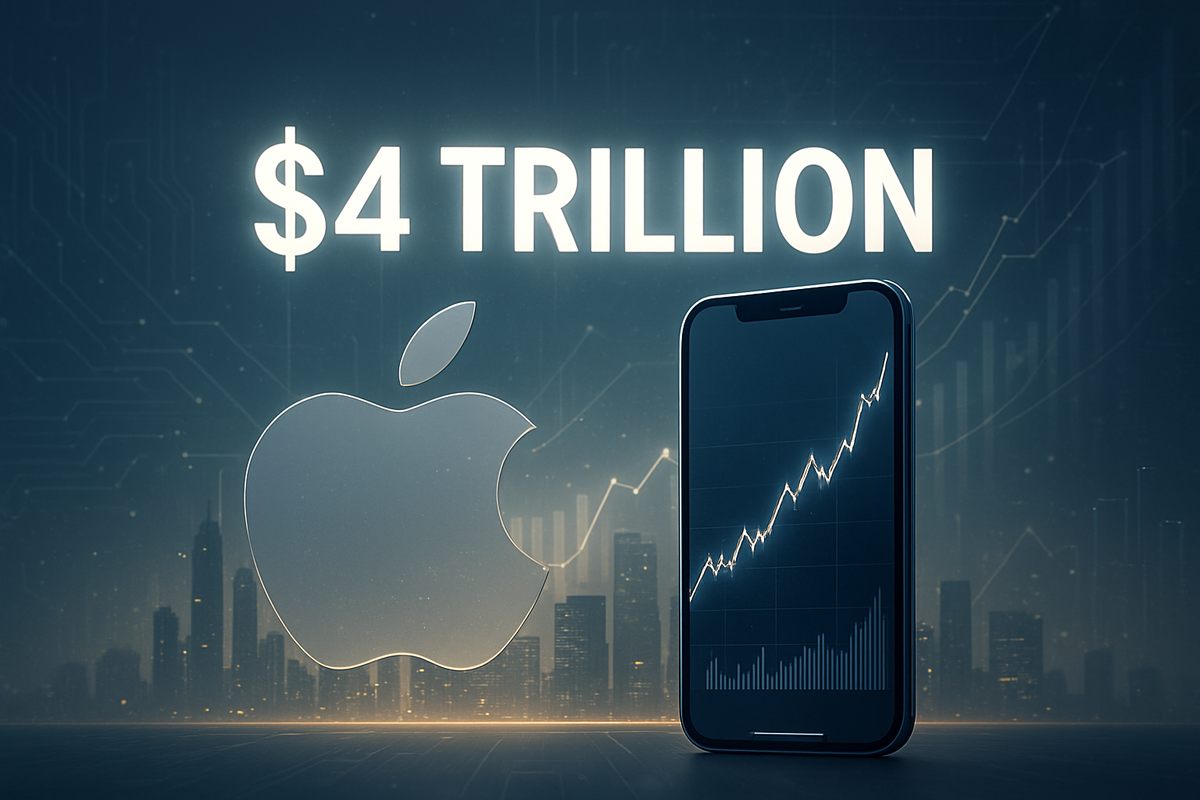
Cupertino, CA – October 28, 2025 – Apple Inc. (NASDAQ: AAPL) today achieved a monumental milestone, briefly surpassing a $4 trillion market capitalization, solidifying its position as one of the world's most valuable companies. This historic feat places Apple in an exclusive club alongside fellow tech titans Nvidia (NASDAQ: NVDA) and Microsoft (NASDAQ: MSFT), both of whom also reached or reclaimed the $4 trillion valuation earlier in 2025. The surge is largely attributed to the robust and better-than-expected demand for its recently launched iPhone 17 series and the new iPhone Air, which have reinvigorated investor confidence and offset lingering concerns about the company's progress in artificial intelligence.
This extraordinary valuation underscores Apple's enduring ability to innovate, maintain unparalleled brand loyalty, and strategically expand its ecosystem. As the company's stock climbed to fresh highs, briefly touching around $269 to $270 in early trading today, the immediate implications for Apple include a significant rebound in stock performance, a powerful affirmation of its product-driven growth strategy, and a temporary alleviation of investor anxieties regarding its AI initiatives. For the broader market, Apple's ascent highlights the continued dominance of the technology sector and signals the robust health of the current bull market, even as it raises questions about market concentration and the sustainability of such lofty valuations amidst global economic uncertainties.
The Journey to Trillions: A Decade of Innovation and Strategic Growth
Apple's path to a $4 trillion market capitalization is the culmination of decades of groundbreaking innovation, meticulous operational execution, and a relentless focus on an integrated hardware, software, and services ecosystem. While the company's foundational years under Steve Jobs laid the visionary groundwork with products like the Macintosh and iPod, its exponential growth in the 21st century has been largely defined by the iPhone era and the strategic leadership of CEO Tim Cook.
The iPhone, first introduced in 2007, fundamentally reshaped the mobile phone industry and created a platform for the App Store, launched in 2008, which became a massive revenue engine. Under Tim Cook's stewardship since 2011, Apple's market capitalization has soared. The company first reached a $1 trillion valuation in August 2018, followed by $2 trillion in August 2020, and briefly touched $3 trillion in January 2022, officially closing above it in June 2023. Key strategic decisions, such as the transition to Apple Silicon (M-series chips) for its Mac and iPad lines, have enhanced performance and efficiency, further bolstering its hardware prowess. The unveiling of the Apple Vision Pro in 2023 marked its ambitious entry into spatial computing.
The immediate catalyst for today's $4 trillion milestone is the overwhelmingly positive reception of the latest iPhone 17 series, which launched on September 9, 2025. Reports indicate the iPhone 17 series outsold its predecessor by 14% in key markets like the U.S. and China during its initial ten days. The introduction of the ultra-slim iPhone Air has also played a significant role in regaining market momentum. Furthermore, Apple's high-margin Services division, encompassing the App Store, iCloud, Apple Music, and Apple TV+, is projected to exceed $100 billion in annual revenue for the first time in fiscal year 2025, demonstrating the immense value of Apple's ecosystem and its ability to drive recurring revenue. Initial market reactions today were highly positive, with shares rising approximately 1%, and analysts like Dan Ives of Wedbush Securities hailing it as a "watershed moment for Cupertino and Big Tech," reaffirming Apple's status as the "best consumer franchise in the world." This achievement also places Apple alongside Nvidia, which is nearing a $5 trillion valuation, and Microsoft, which also re-entered the $4 trillion club today, underscoring the concentrated power of a few technology giants.
Ripple Effects: Winners and Losers in Apple's Wake
Apple's ascent to a $4 trillion market capitalization creates significant ripple effects across various public companies, defining clear winners and those facing intensified pressure. This milestone, driven by strong product demand and a burgeoning services division, solidifies Apple's market dominance and its ability to influence the broader tech ecosystem.
Among the clear winners are Apple's vast network of supply chain partners. Increased demand for iPhones and other devices translates directly into higher production volumes and orders for companies like Foxconn (Hon Hai Precision Industry, TWSE: 2317), Apple's primary assembler. Chip suppliers such as Qualcomm (NASDAQ: QCOM) for modems, Broadcom (NASDAQ: AVGO) for connectivity chips, and especially TSMC (Taiwan Semiconductor Manufacturing Co., NYSE: TSM) for Apple's custom silicon, will see significant benefits. Other component manufacturers, including those providing memory and displays (like Samsung, KRX: 005930), as well as manufacturing partners expanding into regions like India and Vietnam, will also experience increased business as Apple diversifies its production. Furthermore, the expanding Apple user base creates a larger market for app sales and subscriptions, benefiting countless app developers and content providers within the Apple ecosystem. Apple's strategic partnerships with AI companies like OpenAI and Anthropic, for integrating their models into iOS 26 and Xcode respectively, also position these firms as key beneficiaries of Apple's renewed AI push.
Conversely, several companies face increased pressure. Direct competitors in the premium smartphone segment, such as Samsung, will find it even more challenging to compete, forcing them to aggressively differentiate their offerings. Google (Alphabet, NASDAQ: GOOGL), while benefiting from search engine payments, sees Apple's strengthened "walled garden" ecosystem limit its reach within the highly engaged iOS user base and intensifies competition in the AI space. Microsoft (NASDAQ: MSFT), despite its own $4 trillion valuation, faces heightened competition in software and cloud services as Apple's Mac sales grow and its ecosystem deepens. Other smartphone manufacturers (e.g., Xiaomi, HKEX: 1810; Huawei) and PC manufacturers (e.g., HP, NYSE: HPQ; Dell, NYSE: DELL; Lenovo, HKEX: 0992) will also experience greater competition. Beyond hardware, companies in sectors Apple is expanding into, such as health and wellness device companies (e.g., Garmin, NYSE: GRMN), traditional financial services providers, and rival streaming services (e.g., Spotify, NYSE: SPOT; Netflix, NASDAQ: NFLX), will feel the intensified competitive heat from Apple's growing services empire. Apple's privacy-focused features have already reshaped the advertising landscape, challenging many advertisers while boosting Apple's own advertising business.
Wider Significance: A Bellwether for Tech Dominance and Regulatory Scrutiny
Apple's attainment of a $4 trillion market capitalization is far more than just a financial benchmark; it serves as a powerful bellwether for several broader industry trends, signals potential ripple effects across the tech landscape, and brings into sharper focus significant regulatory and policy implications.
This milestone unequivocally underscores the unprecedented dominance of the technology sector in the global economy. Alongside Nvidia and Microsoft, Apple's immense valuation highlights a profound concentration of market power within a handful of tech giants. These companies collectively represent a substantial portion of major market indices, reflecting sustained investor confidence in high-growth technology firms driven by robust consumer demand and diversified revenue streams. This concentration, however, also raises concerns about systemic market risk and the outsized influence these few companies wield. The event also occurs amidst a fervent "AI race," with major players investing hundreds of billions in AI infrastructure. While Apple has been criticized for its cautious approach to AI, its valuation surge is partly attributed to investor confidence in its forthcoming AI advancements, particularly its privacy-focused, on-device processing strategy. This positions Apple uniquely in a landscape where rivals often rely on cloud-centric AI solutions. The enduring strength of Apple's integrated ecosystem – the seamless synergy of hardware, software, and services – remains a pivotal factor, fostering exceptional brand loyalty and recurring, high-margin revenue that few competitors can match.
The ripple effects of Apple's continued ascent are multifaceted. For competitors like Samsung, Google, and Microsoft, it compels accelerated innovation cycles, particularly in emerging areas like AI and spatial computing, creating a more dynamic but intensely competitive market. Partners, especially those involved in chip design (e.g., TSMC) and software development, may see increased investment and collaboration opportunities. However, Apple's immense leverage also means it can demand better terms from suppliers and potentially foster greater competition among them. On the regulatory front, Apple's growing market capitalization inevitably attracts heightened scrutiny. Governments globally are increasingly concerned about antitrust, data privacy, and competition in digital markets. Apple faces ongoing antitrust cases and new legislative frameworks, particularly in Europe, such as the the Digital Markets Act (DMA), which aims to curb the market power of "gatekeeper" platforms. These regulations could impact Apple's lucrative App Store fees and business model, potentially leading to substantial fines for non-compliance. Geopolitical risks, particularly Apple's significant reliance on manufacturing in China, also remain a factor, despite ongoing diversification efforts. Historically, dominant companies have always reflected the prevailing industries of their time, from U.S. Steel in the industrial age to today's information technology giants. While the current market exuberance has led some to draw comparisons to historical market bubbles like the dot-com era, Apple's strong fundamentals and consistent profitability offer a different narrative, though concerns about inflated valuations in the broader tech sector persist.
What Comes Next: Navigating New Frontiers and Intensifying Scrutiny
Apple's achievement of a $4 trillion market capitalization today, October 28, 2025, marks a new chapter, but also sets an even higher bar for future performance. The company's trajectory will be defined by its ability to navigate emerging technological frontiers, adapt to a complex regulatory environment, and sustain innovation at an unprecedented scale.
In the short term (late 2025 - 2026), Apple is poised for continued momentum driven by its core product ecosystem. The strong sales of the iPhone 17 and iPhone Air are expected to continue bolstering revenue. Upcoming hardware refreshes, including M5-powered Macs and iPads, and updates to the Apple Watch and AirPods, will maintain product relevance. A key focus will be the further development and rollout of Apple Intelligence features, with an emphasis on privacy-first, on-device processing, though regulatory compliance, particularly in the EU, may impact feature availability. Long-term (beyond 2026), Apple's future will likely be shaped by advanced AI integration across all devices and services, with a significant overhaul of Siri to be more personalized and contextually aware. New product categories, such as the highly anticipated foldable iPhone (potentially the iPhone 18 series in 2026 or 2027), and continued market penetration in spatial computing with the Vision Pro family, will be crucial. The long-rumored "Apple Car" (Project Titan), an autonomous electric vehicle, remains a significant long-term possibility, with a potential market entry around 2030. The services empire is also expected to continue its aggressive expansion, leveraging Apple's installed base of over 2.2 billion active devices.
To sustain this growth, Apple will require several strategic pivots. An aggressive AI development strategy, despite past criticisms, is already underway, with increased internal investment and potential acquisitions or partnerships with AI leaders like OpenAI or Anthropic. Balancing groundbreaking innovation with stringent regulatory compliance will be paramount, especially as new laws like the EU's Digital Markets Act force changes to its App Store policies and demand greater interoperability. Apple's vertical integration in AI, leveraging its custom silicon for on-device processing, will be a key differentiator. Furthermore, continued diversification beyond the iPhone, through new product categories and aggressive growth in services, is crucial to mitigate reliance on a single product line. Market opportunities abound in the explosive AI market, the growing wearable technology sector, and the emerging spatial computing paradigm. However, challenges include intensifying regulatory scrutiny from antitrust lawsuits in the U.S. and EU, fierce competition from tech giants across all segments, geopolitical risks impacting supply chains, and the continuous pressure to deliver "game-changing" innovation to justify its high valuation expectations.
The Trillion-Dollar Takeaway: Apple's Enduring Power and Future Horizons
Apple's historic achievement of a $4 trillion market capitalization today, October 28, 2025, is a profound statement about its enduring market dominance and future potential. This milestone is not merely a number; it is a testament to the company's remarkable resilience, its ability to consistently innovate, and the unparalleled strength of its integrated ecosystem. The overwhelming success of the iPhone 17 series in a highly competitive market, coupled with the continued explosive growth of its high-margin Services division, has underscored Apple's strategic prowess and its capacity to drive growth even at an immense scale.
Moving forward, the market will continue to be shaped by the powerful trend of concentration within a few mega-cap technology companies, with Apple, Nvidia, and Microsoft leading the charge. These giants, unlike speculative bubbles of the past, are built on strong fundamentals, robust profitability, and significant cash flows, suggesting a more sustainable, albeit concentrated, market landscape. Apple's $4 trillion valuation solidifies its position as a foundational pillar of the global digital economy, granting it immense leverage for future investments in R&D, strategic acquisitions, and further expansion into new high-margin service sectors.
The lasting impact of this event will be seen in how Apple leverages its enhanced market power to define the next generation of technology. Its aggressive push into AI, with a distinct privacy-first approach and on-device processing, coupled with ventures into spatial computing and potentially autonomous vehicles, positions it at the forefront of technological evolution. For investors, the coming months will be critical. Key areas to watch include Apple's upcoming Q4 earnings report on October 30, 2025, which is expected to showcase the full impact of the iPhone 17's success. Furthermore, close attention should be paid to the accelerated rollout of its Apple Intelligence suite, the continued growth trajectory of its Services division, and any developments in new product categories like foldable iPhones or advanced AR/VR devices. Lastly, the company's navigation of intensifying global regulatory scrutiny and its strategies for mitigating geopolitical risks will be crucial determinants of its sustained growth trajectory. Apple's journey to $4 trillion is a powerful reminder that even at the summit, the pursuit of innovation and strategic adaptation remains paramount for lasting success.
This content is intended for informational purposes only and is not financial advice







